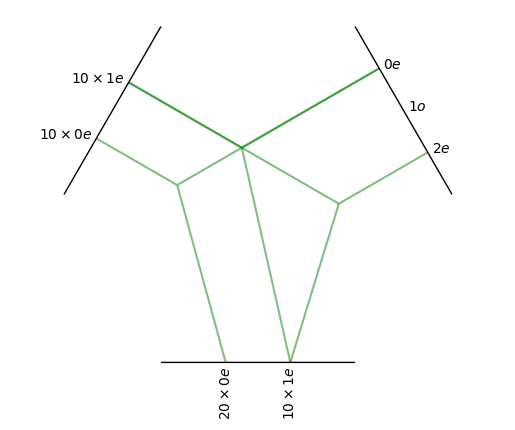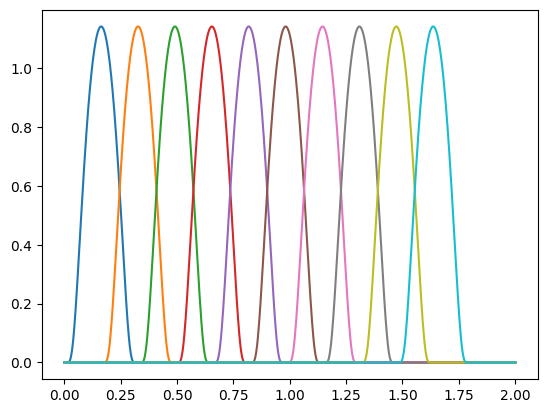Convolution
In this document we will implement an equivariant convolution with e3nn.
We will implement this formula:
where
\(f_j, f'_i\) are the nodes input and output
\(z\) is the average degree of the nodes
\(\partial(i)\) is the set of neighbors of the node \(i\)
\(x_{ij}\) is the relative vector
\(h\) is a multi layer perceptron
\(Y\) is the spherical harmonics
\(x \; \otimes\!(w) \; y\) is a tensor product of \(x\) with \(y\) parametrized by some weights \(w\)
Boilerplate imports
import torch
from torch_cluster import radius_graph
from torch_scatter import scatter
from e3nn import o3, nn
from e3nn.math import soft_one_hot_linspace
import matplotlib.pyplot as plt
Let’s first define the irreps of the input and output features.
irreps_input = o3.Irreps("10x0e + 10x1e")
irreps_output = o3.Irreps("20x0e + 10x1e")
And create a random graph using random positions and edges when the relative distance is smaller than max_radius.
# create node positions
num_nodes = 100
pos = torch.randn(num_nodes, 3) # random node positions
# create edges
max_radius = 1.8
edge_src, edge_dst = radius_graph(pos, max_radius, max_num_neighbors=num_nodes - 1)
print(edge_src.shape)
edge_vec = pos[edge_dst] - pos[edge_src]
# compute z
num_neighbors = len(edge_src) / num_nodes
num_neighbors
torch.Size([3322])
33.22
edge_src and edge_dst contain the indices of the nodes for each edge.
And we can also create some random input features.
f_in = irreps_input.randn(num_nodes, -1)
Note that out data is generated with a normal distribution. We will take care of having all the data following the component normalization (see Normalization).
f_in.pow(2).mean() # should be close to 1
tensor(0.9820)
Let’s start with
irreps_sh = o3.Irreps.spherical_harmonics(lmax=2)
print(irreps_sh)
sh = o3.spherical_harmonics(irreps_sh, edge_vec, normalize=True, normalization='component')
# normalize=True ensure that x is divided by |x| before computing the sh
sh.pow(2).mean() # should be close to 1
1x0e+1x1o+1x2e
tensor(1.)
Now we need to compute \(\otimes(w)\) and \(h\). Let’s create the tensor product first, it will tell us how many weights it needs.
tp = o3.FullyConnectedTensorProduct(irreps_input, irreps_sh, irreps_output, shared_weights=False)
print(f"{tp} needs {tp.weight_numel} weights")
tp.visualize();
FullyConnectedTensorProduct(10x0e+10x1e x 1x0e+1x1o+1x2e -> 20x0e+10x1e | 400 paths | 400 weights) needs 400 weights

in this particual choice of irreps we can see that the l=1 component of the spherical harmonics cannot be used in the tensor product.
In this example it’s the equivariance to inversion that prohibit the use of l=1.
If we don’t want the equivariance to inversion we can declare all irreps to be even (irreps_sh = Irreps("0e + 1e + 2e")).
To implement \(h\) that has to map the relative distances to the weights of the tensor product we will embed the distances using a basis function and then feed this embedding to a neural network. Let’s create that embedding. Here is the base functions we will use:
num_basis = 10
x = torch.linspace(0.0, 2.0, 1000)
y = soft_one_hot_linspace(
x,
start=0.0,
end=max_radius,
number=num_basis,
basis='smooth_finite',
cutoff=True,
)
plt.plot(x, y);

Note that this set of functions are all smooth and are strictly zero beyond max_radius.
This is useful to get a convolution that is smooth although the sharp cutoff at max_radius.
Let’s use this embedding for the edge distances and normalize it properly (component i.e. second moment close to 1).
edge_length_embedding = soft_one_hot_linspace(
edge_vec.norm(dim=1),
start=0.0,
end=max_radius,
number=num_basis,
basis='smooth_finite',
cutoff=True,
)
edge_length_embedding = edge_length_embedding.mul(num_basis**0.5)
print(edge_length_embedding.shape)
edge_length_embedding.pow(2).mean() # the second moment
torch.Size([3322, 10])
tensor(0.8919)
Now we can create a MLP and feed it
fc = nn.FullyConnectedNet([num_basis, 16, tp.weight_numel], torch.relu)
weight = fc(edge_length_embedding)
print(weight.shape)
print(len(edge_src), tp.weight_numel)
# For a proper notmalization, the weights also need to be mean 0
print(weight.mean(), weight.std()) # should close to 0 and 1
torch.Size([3322, 400])
3322 400
tensor(0.0040, grad_fn=<MeanBackward0>) tensor(1.1217, grad_fn=<StdBackward0>)
Now we can compute the term
The idea is to compute this quantity per edges, so we will need to “lift” the input feature to the edges.
For that we use edge_src that contains, for each edge, the index of the source node.
summand = tp(f_in[edge_src], sh, weight)
print(summand.shape)
print(summand.pow(2).mean()) # should be close to 1
torch.Size([3322, 50])
tensor(1.1945, grad_fn=<MeanBackward0>)
Only the sum over the neighbors is remaining
f_out = scatter(summand, edge_dst, dim=0, dim_size=num_nodes)
f_out = f_out.div(num_neighbors**0.5)
f_out.pow(2).mean() # should be close to 1
tensor(1.2428, grad_fn=<MeanBackward0>)
Now we can put everything into a function
def conv(f_in, pos):
edge_src, edge_dst = radius_graph(pos, max_radius, max_num_neighbors=len(pos) - 1)
edge_vec = pos[edge_dst] - pos[edge_src]
sh = o3.spherical_harmonics(irreps_sh, edge_vec, normalize=True, normalization='component')
emb = soft_one_hot_linspace(edge_vec.norm(dim=1), 0.0, max_radius, num_basis, basis='smooth_finite', cutoff=True).mul(num_basis**0.5)
return scatter(tp(f_in[edge_src], sh, fc(emb)), edge_dst, dim=0, dim_size=num_nodes).div(num_neighbors**0.5)
Now we can check the equivariance
rot = o3.rand_matrix()
D_in = irreps_input.D_from_matrix(rot)
D_out = irreps_output.D_from_matrix(rot)
# rotate before
f_before = conv(f_in @ D_in.T, pos @ rot.T)
# rotate after
f_after = conv(f_in, pos) @ D_out.T
torch.allclose(f_before, f_after, rtol=1e-4, atol=1e-4)
True
The tensor product dominates the execution time:
import time
wall = time.perf_counter()
edge_src, edge_dst = radius_graph(pos, max_radius, max_num_neighbors=len(pos) - 1)
edge_vec = pos[edge_dst] - pos[edge_src]
print(time.perf_counter() - wall); wall = time.perf_counter()
sh = o3.spherical_harmonics(irreps_sh, edge_vec, normalize=True, normalization='component')
print(time.perf_counter() - wall); wall = time.perf_counter()
emb = soft_one_hot_linspace(edge_vec.norm(dim=1), 0.0, max_radius, num_basis, basis='smooth_finite', cutoff=True).mul(num_basis**0.5)
print(time.perf_counter() - wall); wall = time.perf_counter()
weight = fc(emb)
print(time.perf_counter() - wall); wall = time.perf_counter()
summand = tp(f_in[edge_src], sh, weight)
print(time.perf_counter() - wall); wall = time.perf_counter()
scatter(summand, edge_dst, dim=0, dim_size=num_nodes).div(num_neighbors**0.5)
print(time.perf_counter() - wall); wall = time.perf_counter()
0.0014800009994360153
0.0013493509995896602
0.002589572000943008
0.0011077569997723913
0.007198666999101988
0.00042959100028383546